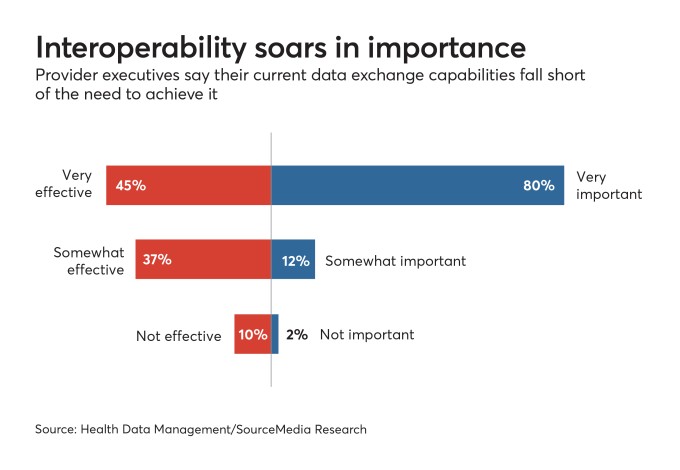Interoperability efforts for electronic health systems in the U.S. are mired in mediocrity.
That’s the assessment of Donald Rucker, MD, the country’s National Coordinator for Health Information Technology. In testimony before the House Energy and Commerce Subcommittee on Health, Rucker graded the nation’s interoperability at, well, less than average.
In fact, Rucker told representatives that health data exchange graded out at C-minus overall. He said health information exchange is “highly patchy” on a national level, with “A students and F students” in different regions—that, in his estimation, “averages out to a C-minus” overall.
“There are more than 100 regional networks and multiple national-level organizations that support health information exchange,” testified Rucker. “While these organizations have made significant progress to expand interoperability, connectivity across networks has been limited.”
But mediocrity in information exchange won’t be tolerated at the federal level much longer. It’s revamping the former EHR incentive program, termed Meaningful Use, now calling it Promoting Interoperability.
Healthcare organizations can read those tea leaves—IT executives see achieving the seamless exchange of health data as one of the industry’s key imperatives for 2019. But they have a tall task in front of them.
A just-completed survey by Health Data Management finds HIT executives feel their organizations’ effectiveness in exchanging health information lags far behind their perception of its importance.
For example, only 18 percent of respondents to the survey said their organizations were extremely effective in sharing digital patient information across systems and teams within their own organizations, while only a quarter (27 percent) said they were very effective in doing so. By contrast, more than a third (36 percent) said interoperability was extremely important to their organization, while 44 percent said the capability was very important.

A variety of factors—primarily the inability to coordinate stakeholders across the industry, as well as challenges in enforcing standards—are hampering interoperability efforts, respondents say.
The study was conducted by Health Data Management and SourceMedia Research, the research arm of HDM’s parent company. A total of 160 responses, primarily from provider organizations, were received in late 2018.
Respondents to the survey can see the handwriting on the wall—interoperability will be important for achieving key healthcare aims, such as the ability to coordinate care across provider organizations for value-based care, and to ensure smooth patient handoffs between providers, just to name a few. In fact, only 2 percent of respondents said interoperability was not important or not very important. By contrast, a total of 80 percent labeled data exchange as very or extremely important.
But capability is lagging, they note. A total of only 45 percent of respondents said they were able to easily exchange data in their organizations (combining totals from those that said they are very or extremely effective).
In recent years, more tools are emerging to facilitate data exchange, such as the growing industry wide support for the Fast Healthcare Interoperability Resources (FHIR), developed by HL7, an industry standards organization. HL7 this month published its eagerly awaited normative version of FHIR—Release 4—and it will be submitted to the American National Standards Institute for designation as an operational standard.
Still, there’s a long way to go in achieving interoperability. For example, in Rucker’s testimony before Congress, he attributed lagging data exchange to “variations and gaps in technical specifications, and in the participation and data use agreements that govern the secure exchange of health information.”
Respondents to the Health Data Management survey highlighted the needs for more consistent use of standards to achieve interoperability. For example, enforcing interoperability standards across care settings and facilities is described as either very or extremely challenging by slightly more than half (51 percent) of survey respondents; another 31 percent say enforcing standards is somewhat challenging.
It’s no easier across the entire industry—enforcing industry wide standards is rated as very or extremely challenging by 52 percent of respondents, with another 31 percent saying implementing such standards is somewhat challenging.
Coordinating stakeholders through interoperability is among the most difficult challenges in the industry, survey respondents noted. Nearly six in 10 (59 percent) rate such coordination as either very or extremely difficult. By contrast, only 7 percent said such coordination is either not challenging or not very challenging.
Survey results back up the findings of the Office of the National Coordinator for Health IT, which in a recent report to Congress noted that healthcare data is not always accessible across systems and by patients, providers and payers.
When it comes to the electronic use and exchange of healthcare information nationally, “hurdles still remain,” the ONC noted in its annual report to Congress.
ONC’s report on interoperability made three recommendations for future actions to accelerate progress. These include:
- Focusing on improving interoperability and upgrading technical capabilities of health IT, so patients can securely access, aggregate and move their health information.
- Increasing transparency in data-sharing practices and strengthening technical capabilities of health IT.
- Prioritizing improving health IT and reducing documentation burden, time inefficiencies and hassle for providers, so they can focus on their patients rather than their computers.
